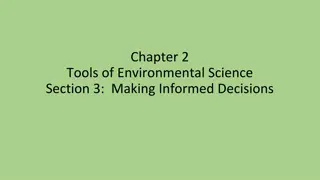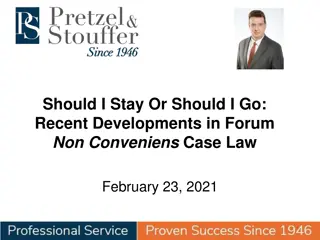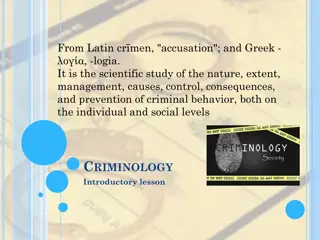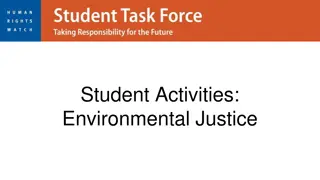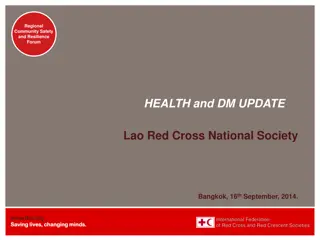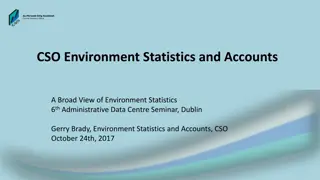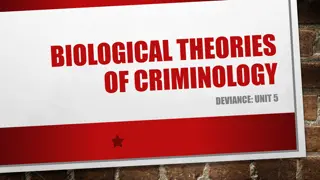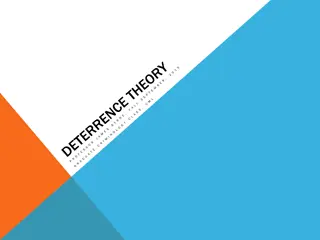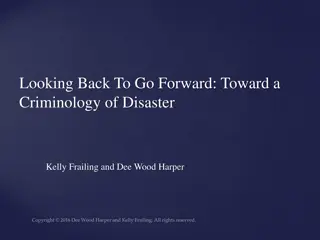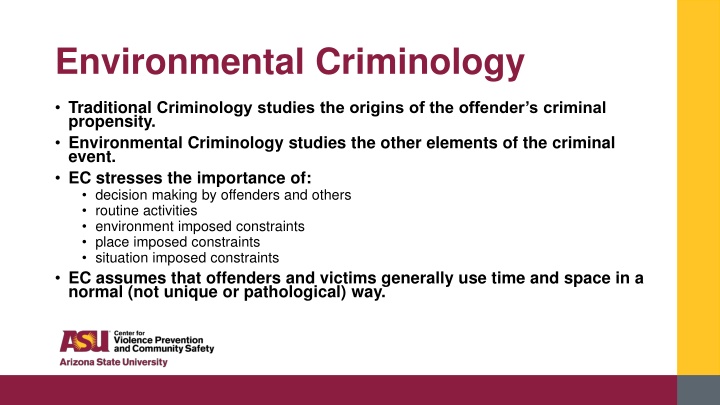
Environmental Criminology: Crime Patterns and Prevention Strategies
Dive into the realm of Environmental Criminology to explore how crime patterns emerge, the role of routine activities, and the significance of factors such as suitable targets and capable guardians in preventing crimes. Discover the theories and principles behind crime events and the importance of understanding offender decision-making within specific environments.
Uploaded on | 1 Views
Download Presentation

Please find below an Image/Link to download the presentation.
The content on the website is provided AS IS for your information and personal use only. It may not be sold, licensed, or shared on other websites without obtaining consent from the author. If you encounter any issues during the download, it is possible that the publisher has removed the file from their server.
You are allowed to download the files provided on this website for personal or commercial use, subject to the condition that they are used lawfully. All files are the property of their respective owners.
The content on the website is provided AS IS for your information and personal use only. It may not be sold, licensed, or shared on other websites without obtaining consent from the author.
E N D
Presentation Transcript
Environmental Criminology Traditional Criminology studies the origins of the offender s criminal propensity. Environmental Criminology studies the other elements of the criminal event. EC stresses the importance of: decision making by offenders and others routine activities environment imposed constraints place imposed constraints situation imposed constraints EC assumes that offenders and victims generally use time and space in a normal (not unique or pathological) way.
3/19/2025 Environmental Criminology Concerned with Crime not Criminals Focus on the Presence or Absence of Opportunities to Offend The Distribution of Crime is a Function of the Distribution of Opportunities To Offend Has Important Implications for Crime Prevention. 2
Crime Pattern Theory Offenders travel like everyone else They go no farther than they need to They find targets in their normal travels They do not use unusual methods of travel They try not to travel huge distances They often do not make special efforts to find targets
3/19/2025 Routine Activity Theory Three elements must converge in time and space for a crime to occur; Motivated offender Suitable Target Value Inertia Visibility Accessibility Lack of capable guardians The lack of any one of these elements can prevent crime 5
3/19/2025 Routine Activity Theory When offenders & targets meet at places repeatedly without controllers crime concentrations appear. Crime 3 Repeat Types: Targets/Victims Offenders Places Place Manager 6
3/19/2025 Absence of a Capable Guardian A capable guardian is anything, either a person or thing, that discourages crimes from taking place. These can be formal or informal. Police Patrols Security Guards Locks Fences Lighting 7
3/19/2025 A Suitable Target A Person An Object A Place 8
3/19/2025 VIVA Value, Inertia, Visibility, Access Value - The offender must either value the target for what they gain or value the effect they have on it. Inertia - The size or weight of an item can effect how suitable it is. Visibility - How visible a target is can affect its suitability. Access - If a target is easy to get to, this increases its suitability. 9
3/19/2025 Motivated Offenders Why People Commit Crime Gain/Need Poverty or a drug habit Society/Experience/Environment Peer pressure, coercion, lack of education Beliefs Belief that some crimes aren t wrong, protest 10
3/19/2025 So, for a crime to occur: ...a motivated offender must find a suitable target in the absence of a capable guardian... 11
3/19/2025 Elements of Routine Activity Theory A suitable target is available. There is a lack of a capable guardian to prevent the crime from happening. A motivated offender is present. 12
3/19/2025 The Problem Analysis Triangle Revisited 13
3/19/2025 The Complete Problem Analysis Triangle 14
3/19/2025 Offenders can sometimes be controlled by other people: these people are know as handlers. Targets and victims can sometimes be protected by other people: those people are known as guardians. Places are usually controlled by someone: those people are known as managers 15
3/19/2025 A First Cut at Prevention Remove one of these elements Place Manager Add one of these controllers 16
3/19/2025 Situational Crime Prevention Too much emphasis on the origins of criminal disposition and not enough emphasis on the role of opportunity Disposition are hard to change Societal conditions are hard to change Opportunities are easier to manipulate The nature of criminal opportunities influence the amount, nature, and location of crime. 17
3/19/2025 25 Crime Prevention Methods REDUCE PROVOCATIONS Reduce stress Avoid disputes Reduce emotional arousal Neutralize peer pressure Discourage imitation REMOVE EXCUSES Set rules Post instructions Alert conscience Assist compliance Control alcohol & drugs INCREASE RISK Extend guardianship Assist natural surveillance Reduce anonymity INCREASE THE EFFORT Harden targets Control access to facilities Screen exits Deflect offenders Control tools/weapons Use place managers Strengthen formal surveillance REDUCE REWARDS Conceal targets Remove targets Identify property Disrupt markets Deny benefits 18
3/19/2025 Crime Pattern Theory Revisited 19
3/19/2025 Clustering of Crime/Criminals Repeat offenders focusing on different targets at different places Repeat victims repeatedly attacked by different offenders at different places Repeat places (or hot spots ) involving different offenders and different targets interacting at the same place 20
3/19/2025 Incident Clusters Behaviors. Certain behaviors are common to the incidents. Places. Certain places can be common to incidents. Persons. Certain individuals or groups of people can be common to incidents. Times. Certain times can be common to incidents. 21
3/19/2025 Conclusion Opportunity has been neglected in criminology Personal and social variables are important but difficult for police to address Crime is a product of interactions between people and their environment Opportunity theory enhances prevention by focusing as much on targets and guardians as on the offender Displacement rarely becomes a problem Crime opportunity deals with one of the most important and controllable contributing factors of crime, which is the decision to commit crime 22
3/19/2025 The 80-20 Rule Generally, a small number of things are responsible for a large proportion of outcomes. For example, a small number of hurricanes account for a large amount of the overall damage. Similarly, small numbers of offenders (20%) are responsible for a large number (80%) of the crimes; or, 20% of the victims may account for 80% of the victimizations; or, 20% of places are the locations for 80% of the crimes. The percentages vary by the particular problem, but the rule is important because crime is highly concentrated on particular people, places, and things. 23
3/19/2025 Does the 80-20 Rule Apply? Repeat Offenders Repeat Targets/Victims (Hot Products) Repeat Places or Hot Spots (Risky Facilities) Repeat Times crimes may also be concentrated in time (e.g., DWI on Friday nights). 24
3/19/2025 Rational Choice Theory Decisions to offend are constrained by time, cognitive ability and information Perceptions of the situation and of risks and rewards is more important that actual circumstances Decisions vary by the different stages of the offense and among different offenders Individuals who are not normally criminals may choose to offend based on the perceived risks and rewards If offenders choose to commit crimes based on a number of factors, then those factors can be altered to discourage them from choosing to offend Crime in many circumstances is not inevitable!! 25
3/19/2025 Opportunity Theory Principle Opportunity Makes the Thief 26
3/19/2025 10 Principles of Crime Opportunity 1. Opportunities play a role in causing all crime, not just common property crime. 2. Crime opportunities are highly specific. 3. Crime opportunities are concentrated in time and space. 4. Crime opportunities depend on everyday movements of activity. 5. One crime produces the opportunities for another. 27
3/19/2025 10 Principles of Crime Opportunity 6. Some products offer more tempting crime opportunities. 7. Social and technological changes produce new crime opportunities. 8. Crime can be prevented by reducing opportunities. 9. Reducing opportunities does not usually displace crime. 10. Focused opportunity reduction can produce wider declines in crime. 28
3/19/2025 Conclusion Opportunity has been neglected in criminology Personal and social variables are important but difficult for police to address Crime is a product of interactions between people and their environment Opportunity theory enhances prevention by focusing as much on targets and guardians as on the offender Displacement rarely becomes a problem Crime opportunity deals with one of the most important and controllable contributing factors of crime, which is the decision to commit crime 29
3/19/2025 Thank You! 30



